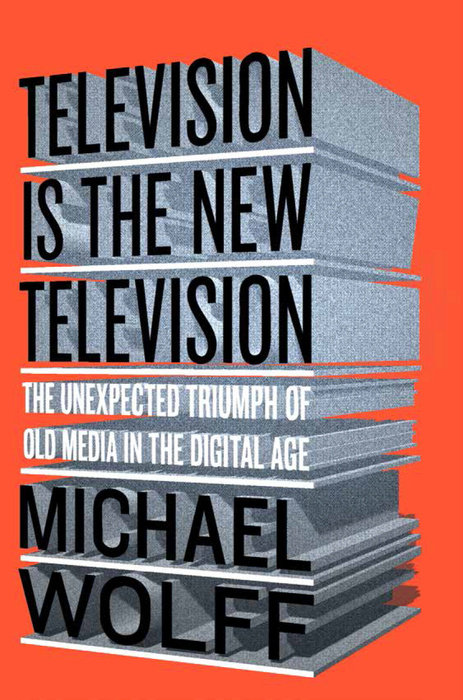
Media columnist Michael Wolff, who regularly excoriates the media’s reporting on itself, has turned his acerbic attention to TV. The death of television, he argues in his new book, has been greatly exaggerated. It’s very much alive and kicking, he argues in “Television Is the New Television: The Unexpected Triumph of Old Media in the Digital Age.”
In recent years television—not just PBS, but HBO, Netflix, and others—has assumed a greater importance for journalism because it has become a major platform for documentaries. PBS still showcases the American Experience series and the work of Ken Burns, while HBO has jumped in with documentaries like the six-part “The Jinx: The Life and Deaths of Robert Durst,” which made headline news when it aired this spring. CNN’s film division made “Life Itself,” about the late film critic Roger Ebert. ESPN has earned acclaim for its “30 for 30” documentary series about important moments in sports. Netflix has about 50 million subscribers globally and has had an Oscar-nominated documentary in each of the last two years, “The Square” about the uprising in Egypt’s Tahrir Square and “Virunga: Gorillas in Peril.”
The conventional narrative about “disruptive innovation” has held that the Internet is disrupting television. Wolff maintains that it’s the other way around: Television is disrupting the Internet. He points to Netflix as a prime example of the phenomenon, and in this excerpt from his book, he lays out his argument.

This is an edited excerpt from “Television Is the New Television: The Unexpected Triumph of Old Media in the Digital Age” by Michael Wolff
Penguin Random House
Copyright 2015 Michael Wolff
The solipsism of the tech community sees Netflix as a satisfying disruption of the TV business. But that’s a striking inversion of what’s actually happening: TV is disrupting the Internet.
It is not Netflix bringing digital to television, but, quite obviously, Netflix bringing television programming and values and behavior—like passive watching—to heretofore interactive and computing-related screens.
Netflix was a commerce company delivering DVDs, no more part of the media business, or show business, than Blockbuster, the video rental company that once had outposts in strip malls everywhere. But this early origin and business model (you paid them) became the crucial difference in its efforts to break out of the fulfillment business—the need to get paid (or the habit of being paid) pushed Netflix beyond the limitations of digital media.
This was mostly a happenstance segue. Netflix initially was not going into the media business. Rather, it was a disrupter of retail models, first delivering DVDs by mail, offering a larger selection and lower cost, and then delivering the same product via new streaming technology. Both advances transformed the video rental market. But the perception in the marketplace and at Netflix that this further advance had moved it from the retail business and into the realm of HBO and premium paid television was after the fact, a dawning realization.
Mirabile dictu: Netflix was the first successful seller of content in the digital world. It proved the subscription model.
And one more unwitting breakthrough: Up until Netflix, television had always been organized on a geographical model. Networks were an association of local affiliates; cable systems, even consolidated ones, were a collection of exclusive licenses to wire specific communities; cable stations lived or died on their ability to make deals with local cable franchises. And, of course, none of this transcended national borders.
Netflix, on the other hand, implemented its streaming service—pivotally with a third-party license of content through Starz, a second-level cable pay-TV service—on a national basis overnight.
Internet protocol (IP) destroyed the myth of television localism—and that there were daunting hurdles in creating a television network.
There was one more crucial aspect to Netflix’s transformation into media, and its lightning rise to a competitive television network: its CEO, Reed Hastings.
Hastings is a salesman. He describes himself in all the ways that tech guys like to describe themselves, as an entrepreneur, as an engineer, as someone surely with the temperament of a technical and software visionary. But really what distinguishes Hastings is that he sells. He courts; he schmoozes; he begs. He has built what he would like to characterize as a tech company not as tech companies are built, on platform functionality, but as media companies are built, on his ability to make deals and then trade up to better deals.
Curiously, among the many formative moments in the company’s development, the loss of its Starz deal, which gave it a trove of movie licenses, a seemingly certain setback, encouraged it to make a different kind of deal that would transform it once again: Netflix had to license television programs. And rather within a blink of an eye, it went from being a feature film rental site (a few million people a day go to the movies) to being a rerun television network (40 to 50 million people a night watch television).
It not only became a de facto television channel, it established the crossover market of licensing deals for television shows. Television’s major, if not singular, preoccupation—looking for downstream markets for its product—suddenly had another outlet. Not only was digital, in this regard, not competitive with television, it was a wholly unexpected expansion of ancillary revenue. Digital became part of the television business. An additional Netflix contribution was to turn heretofore ad‑support network shows into paid products too.
Reed Hastings and Netflix, surprising nobody so much as themselves, woke up as a television channel. Other than being delivered via IP, Netflix had almost nothing to do with the conventions of digital media. It is not user generated, it is not social, it is not free. It is in every way, except for its route into people’s homes—and the differences here would soon get blurry—the same as television. It was old-fashioned, passive, narrative entertainment.
When it began its move into original programming it rushed to say, in an effort to project its technology bona fides, that its user data gave it the wherewithal to more finely calibrate the market, the zeitgeist, and the chances for a hit. Many press accounts of “House of Cards,” its first original production, had it as the miraculous result of a big data, big brother confection of heretofore unimagined audience research. In fact, it was a project that its producer and star, Kevin Spacey, had been shopping to all the major television outlets. It landed at Netflix because it had been unsuccessful in finding another home. Its success was an example not of data, but in classic television and show business fashion, the caprice and luck of a needy buyer meeting an eager seller.
Netflix had merely recreated the premium channel television business, in its economic and narrative structure, different only in the way that it had established a third distribution track. There was broadcast, cable, and, after Netflix, IP, but surely this was more an expanding television business rather than an expanding digital business. There was, in fact, rather little that Netflix depended on from the digital system of networked traffic and advertising revenue, whereas it was entirely dependent on its ability to license television content and to attract top writing, acting, producing, and directing talent.
And yet Netflix became a new digital standard-bearer. In 2014 a New Yorker profile effectively made Netflix the official television killer (there have been many prior television killers). Ken Auletta, writing about the media business for many decades, is surely the voice of the establishment in the field, conferring dominance to the players he covers. Very little in this particular piece was new. Rather, the approach here—putting a lot of well-known sources on the record in support of the current and popular thesis—is meant to solidify, rather than challenge, a widespread impression, and to thereby stand as the definitive statement. It is an instructive example of a kind of Silicon Valley agitprop that is so often retailed through traditional reporters and that then becomes the conventional wisdom adopted by the financial community as well as by other journalists.
“Television,” says Auletta, as his pro forma thesis, “is undergoing a digital revolution.”



